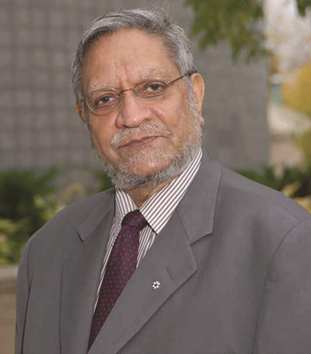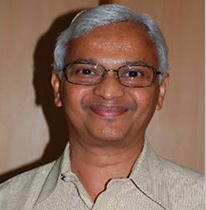Founder, International Academy of Cardiovascular Sciences
The International Academy of Cardiovascular Sciences was founded in 1996 and is headquartered in Winnipeg, Manitoba, Canada. Established by renowned Cardiovascular Scientists, Surgeons and Cardiologists, the Academy provides the organizational structure for the world-wide sharing of research and education information in the field of heart health.

Professor NS Dhalla
Founder Executive Director
Professor NS Dhalla in an interview with the American Physiological Society
Professor Naranjan S Dhalla is the founder executive director of the International Academy of Cardiovascular Sciences since its establishment in 1996. Born in Ghanieke, Punjab, India, Professor Dhalla received a Bachelor of Science in Physics and Chemistry from Panjab University in 1956, an A.I.C. in Chemistry from the Institution of Chemists in Calcutta, India in 1961, a Master of Science in Pharmacology from University of Pennsylvania in 1963, and a Ph.D. in Pharmacology from University of Pennsylvania in 1965. In 1968, he joined the University of Manitoba as an assistant professor in physiology. In 1972, he became an associate professor and a full professor in 1974. In 1991, he was appointed a distinguished professor of physiology. From 1996 to 2006, he was the director of St. Boniface Hospital Research Centre's Institute of Cardiovascular Sciences. He currently serves as the executive director of the International Academy of Cardiovascular Sciences.
Professor Dhalla is a world leader in promoting cardiovascular education. Earlier Professor Dhalla had served the International Society for Heart Research as secretary general from 1972 to 1988 and as president elect, president, and past president from 1989 to 1998. He is credited for expanding the reach of the ISHR by establishing chapters in Russia, China, Japan, India, South America and in many other countries of the world. Now, he has been promoting the International Academy of Cardiovascular Sciences to make it a unique forum for the exchange of information in the world. The IACS is structured with an international executive and board members, with headquarters in Winnipeg, Manitoba, Canada. At present, the Academy has established seven sections in India, Japan, China, Russia, Europe, South and North America which are operating independently, but in a coordinated fashion. IACS has 234 Fellows and 22 Fellows Emeritus (cardiologists, cardiac surgeons and scientists from more than 40 countries), who have been elected in recognition of their distinguished achievements. IACS presents endowed awards and bestows its prestigious Medals of Merit annually.
Our Mission

To promote cardiovascular education of professionals and lay people and to recognize major cardiovascular achievement throughout the world.
MoA

President’s Message
This year Professor Ramesh Goyal and colleagues at Delhi University of Pharmaceutical Sciences at New Delhi had conceived an appropriate, timely and significant theme for our annual meeting in February.
In the early days of medical education, in my own discipline of Pathology, there was only one department, which,by the time when I was an undergraduate had divided into Pathology, Microbiology and Forensic Medicine. At the time I started my career as a teacher, Pathology department had further split to create new departments of histopathology, cytology, immunology, haematology, laboratory medicine, bacteriology, virology, parasitology, mycology and transfusion medicine. Similar partitions had happened also in other disciplines. Comparable separations have happened in professional societies as well. In Cardiology for example, we have societies for individual diseases such as heart failure, hypertension, rhythm disorders, atherosclerosis, and pulmonary vascular diseases and individual associations of clinical cardiologists, angiologists, phlebologists, coronary interventionists, nuclear cardiologists,electrocardiologists and echocardiographers. Possibly, there must be some advantage in this kind of classified growth. Be that as it may, I feel this spread in educational structure and professional organizations have resulted in a decline in the number of professionals and scientists who have breadth of knowledge and interests. They have reduced capacity to identify and solve health problems, which are complex in origin and demand manifold management strategies.
Another impact of the divisions has been on research funding. Greg Petsko, a distinguished structural biologist had voiced his concern about, I quote “theBalkanization of biomedical research funding by disease phenotype and organ system’.
Petsko in his article in BMC Biology argues that we need to ‘think more aboutpathways and processes within the cell and organism’. Professor P. Balaram, former Director of Indian Institute of Science, Bangalore in an editorial in Current Scienceopined, I quote: “No major problem of our time inthe areas of health, environment or energy is likely to besolved by a narrow, specialist approach. Teams whosemembers possess complementary skills need to be builtand fostered. There is indeed a great need to experimentwith new approaches to building structures for scientificresearch.”
It is in this context, that the new approach of Convergence Research attracts attention.
Some of you may be aware that four years ago, the National Science Foundation (NSF) in the United states, identified Convergence Research as one of the ten Big Ideas for Future NSF Investments. Convergence research is a way of solving complex problems integrating knowledge, methods, and expertise from different disciplines and forming novel frameworks to catalyze scientific discovery and innovation. Convergence research aims to integrate disciplines – it is multidisciplinary, transdisciplinary and interdisciplinary.
NSF identifies Convergence Research as having two primary characteristics:
- Research driven by a specific and compelling problem arising from either profound scientific questions or imperative societal needs.
- Broad integration across disciplines resulting in (i) experts from different disciplines pursuing common research challenges, (ii) integration of their knowledge, mode of thinking, methods, tools and data, creating new frameworks, paradigms or even a new scientific language, and (iii) development of novel ways of framing research questions, and opening new research vistas.
I think that meetings which focusses on convergence of professionals from multiple disciplines would provide new learning opportunities and experiences to graduate students, postdocs as well as clinicians and scientists in their early career; that would help prepare them to become the next generation of convergence researchers. Hopefully, they would recognize how to use new tools, instruments, and techniques that are central to convergence research and learn the concepts they would need to learn, outside of their own disciplinary specialties and also how to acquire them.
Howard Morgan, the founder President of our Academy said, I quote: "The challenge for the Academy and its members is to adopt a mind-set, which continuously raises the question of how new and existing knowledge can be translated into prevention, improved diagnosis and therapy of cardiovascular disease. This approach offers the hope of a continued reduction in morbidity and mortality due to cardiovascular diseases.” I wish to emphasize his phrase “adopt a mind-set, which continuously raises the question of how new and existing knowledge, can be translated”. If it is Convergence Research, be it so.
On that note, I conclude.
I look forward to meet you all during our next annual meeting at Central Drug Research Institute at Lucknow. Mark the dates – 25 to 27 February 2021- in your calendar.


